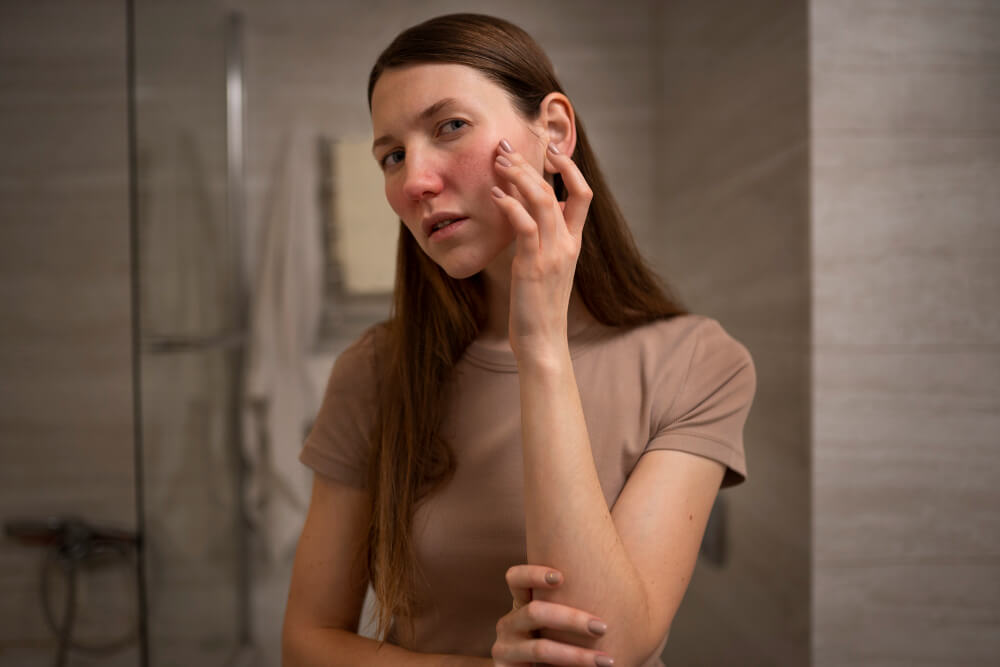What Causes Bruising After an Injection? How to Prevent It?
Bruising is a small blood leak under the skin that shows up as a colored mark. Injection bruising is a common occurrence after cosmetic or medical treatments. This happens when tiny blood vessels get damaged during the procedure. Bruising is generally not dangerous and fades on its own over time.
Many people find that using a blunt tip cannula for dermal fillers lips may reduce bruising risk compared to traditional needles.
What Causes Bruising After an Injection
Bruising after an injection occurs when blood vessels are accidentally punctured during needle insertion. The needle tip can break tiny capillaries under the skin. This causes blood to leak into the surrounding tissue.
The depth of injection plays a role in bruising risk. The injection site also matters – areas around the eyes or lips have more blood vessels. Why do you bruise after an injection? The injection technique used by your provider makes a big difference.
Needles tend to increase bruising risk compared to cannulas. This is because needles pierce through tissue more aggressively. A cannula vs needle comparison shows cannulas glide around blood vessels instead of piercing them.
The most common causes include:
- Thin or sensitive skin that bruises easily
- Use of blood thinners or supplements
- Poor injection technique by inexperienced providers
- Fragile capillaries in treated areas
Who Is More Likely to Bruise

Individual factors increase bruising likelihood during aesthetic treatments. Age affects bruising risk because skin thins with age. Older patients often see more bruising after injections. Skin tone can make bruises more visible on lighter skin compared to darker skin tones.
Medical conditions that affect blood clotting increase the risk of bruising. Patients taking prescription blood thinners need special care.
Lifestyle factors also play a role in how much someone might bruise:
- Smoking reduces blood flow and slows healing. This can make bruising worse and last longer.
- Drinking alcohol before treatment thins the blood temporarily. This increases the chance of bruising during injectable procedures. Strenuous workouts right after injections pump more blood to the treated areas. This can worsen bruising and swelling.
How to Prevent Bruising After an Injection
Taking steps before, during, and after injection helps minimize bruising. Before your appointment, avoid alcohol for several days. Stop taking aspirin, ibuprofen, fish oil, and vitamin E if your doctor approves. These act as mild blood-thinning medications.
During the treatment, make sure your provider uses a gentle injection technique. An experienced injector knows how to avoid blood vessels. They should work slowly and carefully in sensitive areas.
After your injection, apply ice packs to the affected area. Keep your head elevated when resting. Stay upright for a few hours after treatment. This helps reduce blood flow to the injection site.
Consider asking your provider about blunt cannulas to reduce trauma. You can buy cannulas and needles explicitly designed for safer injections. Many providers now prefer cannulas for reducing bruising risk.
Best Practices for Faster Recovery
Following a simple checklist speeds up the healing process after aesthetic injections. These practices help minimize bruising and get you back to normal faster.
Do use a cold compress for the first 24 hours. Apply it for 10-15 minutes at a time. Do keep the head elevated when sleeping or resting. This helps drain excess fluid from the treated area. Do apply arnica or bromelain cream if your provider suggests it. These natural remedies may help with bruising.
Don’t touch or massage the area unless instructed. This can spread bruising or cause other problems. Don’t do heavy workouts for 24 hours after treatment. Increased blood flow can worsen bruising. Don’t apply direct heat like hot compresses in the first few days.
Good sleep, staying hydrated, and gentle skincare help recovery. Eat foods rich in vitamin C to support healing. Avoid smoking as it slows down the body’s natural healing process.
When to Consider Switching to a Cannula

A cannula is a flexible, rounded tube used for injections. Unlike sharp needles, cannulas have blunt tips that glide around blood vessels. This design makes them less likely to puncture capillaries during treatment.
Many professionals choose cannulas over needles for specific reasons. There’s less risk of piercing blood vessels with the blunt tip design. Fewer entry points are needed to treat larger areas. This means less trauma to the skin overall. Smoother product distribution happens because the cannula moves under the skin.
Popular uses include blunt-tip cannulas for lip and cheek enhancement. The flexible design works well for areas that need volume. Patients often report less bruising when cannulas are used properly.
Not all procedures work well with cannulas, though. Fine lines and precise work may still need traditional needles. Your provider should explain which option works best for your specific treatment goals.
References (APA)
Balci Akpinar, R., & Celebioglu, A. (2008). Effect of injection duration on bruising associated with subcutaneous heparin: A quasi experimental within-subject design. International Journal of Nursing Studies, 45(6), 812-817.
Gaertner, K., Baumgartner, S., & Walach, H. (2021). Is homeopathic arnica effective for postoperative recovery? A meta-analysis of placebo-controlled and active comparator trials. Frontiers in Surgery, 8, 680930.
Glogau, R. G., & Kane, M. A. C. (2008). Effect of injection techniques on the rate of local adverse events in patients implanted with nonanimal hyaluronic acid gel dermal fillers. Dermatologic Surgery, 34(s1), S105-S109.
King, M. (2017). The management of bruising following nonsurgical cosmetic treatment. Journal of Clinical and Aesthetic Dermatology, 10(2), E1-E4.
Leu, S., Havey, J., White, L. E., Martin, I., Yoo, S., Rademaker, A. W., & Alam, M. (2010). Accelerated resolution of laser-induced bruising with topical 20% arnica: A rater-blinded randomized controlled trial. British Journal of Dermatology, 163(3), 557-563.
Nestor, M. S., Ablon, G. R., & Stillman, M. A. (2010). The use of a contact cooling device to reduce pain and ecchymosis associated with dermal filler injections. Journal of Clinical and Aesthetic Dermatology, 3(3), 29-34.
Niamtu, J. (2009). Filler injection with micro-cannula instead of needles. Dermatologic Surgery, 35(12), 2005-2008.



